
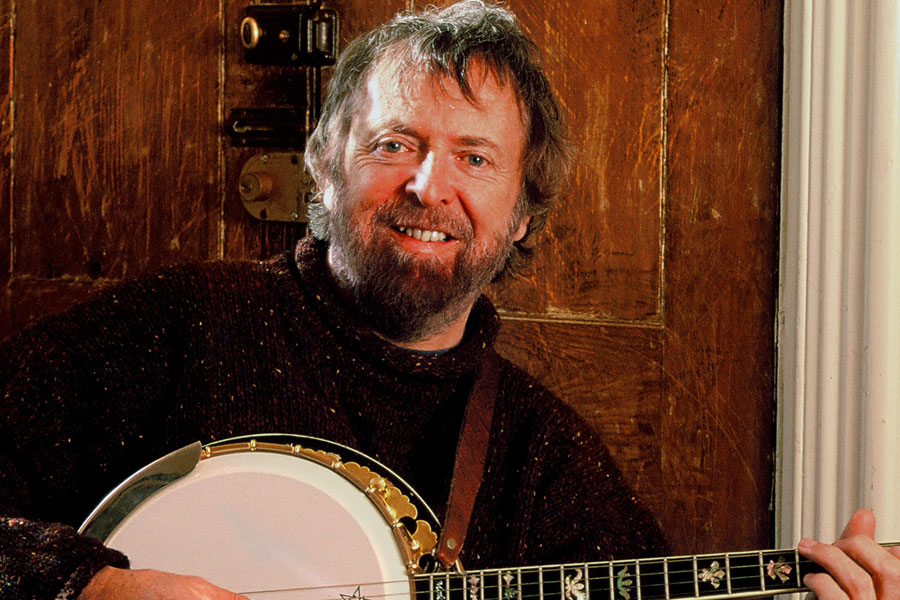
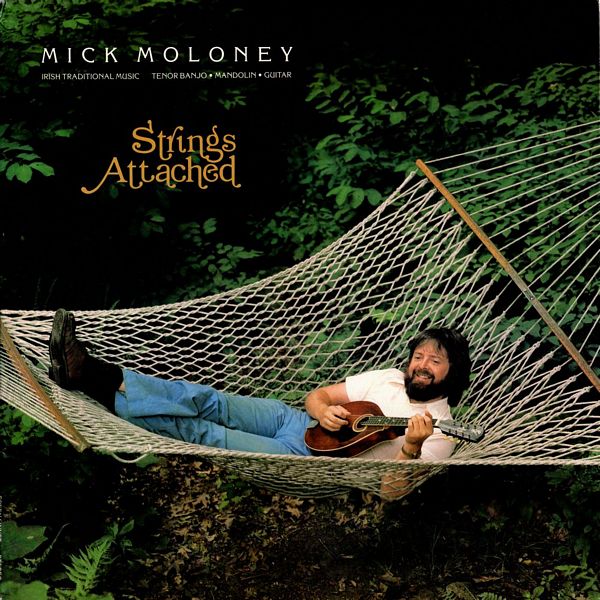 |
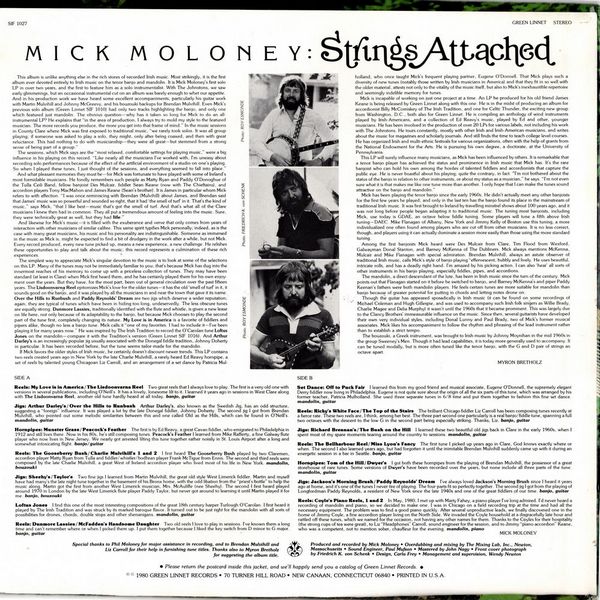
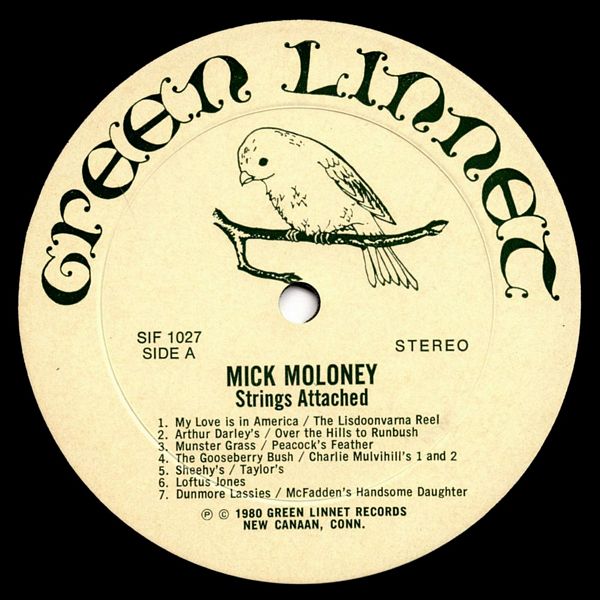
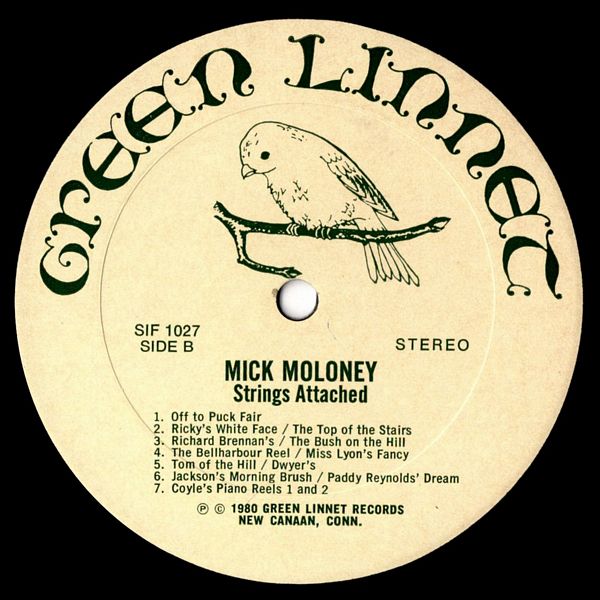 |
Sleeve Notes
This album is unlike anything else in the rich stores of recorded Irish music. Most strikingly, it is the first album ever devoted entirely to Irish music on the tenor banjo and mandolin. It is Mick Moloney's first solo LP in over two years, and the first to feature him as a solo instrumentalist. With The Johnstons, we saw early glimmerings, but an occasional instrumental cut on an album was barely enough to whet our appetite. And in his production work we have heard some excellent accompaniments, particularly his guitar work with Martin Mulvihill and Johnny McGrecvy, and his bouzouki backups for Brendan Mulvihill. Even Mick's previous solo album (Green Linnet SIF 1010) had only two tracks highlighting the banjo, and only one which featured just mandolin. The obvious question — why has it taken so long for Mick to do an all-instrumental LP? He explains that "in the area of production, I always try to mold my style to the featured musician. The more records you produce, the more you get into that frame of mind." In the music sessions in County Clare where Mick was first exposed to traditional music, "we rarely took solos. It was all group playing; if someone was asked to play a solo, they might, only after being coaxed, and then with great reluctance. This had nothing to do with musicianship — they were all great — but stemmed from a strong sense of being part of a group."
The sessions, which Mick says are the "most relaxed, comfortable settings for playing music," were a big influence in his playing on this record. "Like nearly all the musicians I've worked with, I'm uneasy about recording solo performances because of the effect of the artificial environment of a studio on one's playing. So when I played these tunes, I just thought of the sessions, and everything seemed to fall into place."
And what pleasant memories they must be — for Mick was fortunate to have played with some of Ireland's most formidable musicians. He fondly remembers such people as Matty Ryan and Paddy O'Donoghue of the Tulla Ceili Band, fellow banjoist Des Mulcair, fiddler Seán Keane (now with The Chieftains), and accordion players Tony MacMahon and James Keane (Seán's brother). It is James in particular whom Mick refers to with affection. "I was once reminiscing with Brendan (Mulvihill) about James, and Brendan said that James' music was so powerful and sounded so right, that it had 'the smell of turf in it. That's the kind of music," says Mick, "that I like best — music that's got the smell of turf. And that's what all of the Clare musicians I knew then had in common. They all put a tremendous amount of feeling into the music. Sure, they were technically great as well, but they had life."
And likewise for Mick's music — it is filled with the exuberance and verve that only comes from years of interaction with other musicians of similar calibre. This same spirit typifies Mick personally; indeed, as is the case with many great musicians, his music and his personality are indistinguishable. Someone as immersed in the music as Mick is, might be expected to find a bit of drudgery in the work after a while, but not Mick. Every record produced, every new tune picked up, means a new experience, a new challenge. He relishes these opportunities to play and talk about the music; this record represents a culmination of these rich experiences.
The simplest way to appreciate Mick's singular devotion to the music is to look at some of the selections on this LP. Many of the tunes may not be immediately familiar to you; that's because Mick has dug into the innermost reaches of his memory to come up with a priceless collection of tunes. They may have been standard (at least in Clare) when Mick first heard them, and he has certainly played them for his own enjoyment over the years. But they have, for the most part, been out of general circulation over the past fifteen years. The Lisdoonvarna Reel epitomizes Mick's love for the older tunes — it has the old 'smell of turf in it, it sounds good on the banjo, and it was played by all the musicians in and near the town that gave it its name. Over the Hills to Runbush and Paddy Reynolds' Dream are two jigs which deserve a wider reputation; again, they are typical of tunes which have been in hiding too long, undeservedly. The less obscure tunes are equally strong. Dunmore Lassies, traditionally identified with the flute and whistle, is given a new lease on life here, not only because of its adaptability to the banjo, but because Mick chooses to play the second part of the tune first, completely changing its nature. My Love is in America is a favorite of fiddlers and pipers alike, though no less a banjo tune. Mick calls it "one of my favorites. I had to include it — I've been playing it for many years now." He was inspired by The Irish Tradition to record the O'Carolan tune Loftus Jones on the mandolin — compare it with the Tradition's version (Green Linnet SIF 1016). And Arthur Darley's is an increasingly popular jig usually associated with the Donegal fiddle tradition, Johnny Doherty in particular. It has been recorded before, but the tune seems tailor-made for the mandolin.
If Mick favors the older styles of Irish music, he certainly doesn't discount newer trends. This LP contains two reels created years ago in New York by the late Charlie Mulvihill, a rarely heard Ed Reavy hornpipe, a set of reels by talented young Chicagoan Liz Carroll, and an arrangement of a set dance by Patricia Mulholland, who once taught Mick's frequent playing partner, Eugene O'Donnell. That Mick plays such a diversity of new tunes (notably those written by Irish musicians in America} and that they fit in so well with the older material, attests not only to the vitality of the music itself, but also to Mick's inexhaustible repertoire and seemingly indelible memory for tunes.
Mick is incapable of working on just one project at a time. An LP he produced for his old friend James Keane is being released by Green Linnet along with this one. He is in the midst of producing an album for accordionist Billy McComiskey of The Irish Tradition, and one for Celtic Thunder, the exciting new group from Washington, D.C., both also for Green Linnet. He is compiling an anthology of wind instruments played by Irish-Americans, and a collection of Ed Reavy's music, played by Ed and other, younger musicians. He has been involved in the production of over 20 LPs for various labels, not including his work with The Johnstons. He tours constantly, mostly with other Irish and Irish-American musicians, and writes about the music for magazines and scholarly journals. And still finds the time to teach college level courses. He has organized Irish and multi-ethnic festivals for various organizations, often with the help of grants from the National Endowment for the Arts. He is pursuing his own degree, a doctorate, at the University of Pennsylvania
This LP will surely influence many musicians, as Mick has been influenced by others. It is remarkable that a tenor banjo player has achieved the status and prominence in Irish music that Mick has. It's the rare banjoist who can hold his own among the hordes of talented fiddlers and accordionists that capture the public eye. He is never boastful about his playing; quite the contrary, in fact. ' I'm not bothered about the status of the banjo in relation to other instruments, or about my status as a musician." he says. 'Tm not even sure what it is that makes me like one tune more than another. I only hope that I can make the tunes sound attractive on the banjo and mandolin."
Mick has been playing the tenor banjo since the early 1960s. He didn't actually meet any other banjoists for the first few years he played; and only in the last ten has the banjo found its place in the mainstream of traditional Irish music. It was first brought to Ireland by travelling minstrel shows about 100 years ago, and it was not long before people began adapting it to traditional music. The tuning most banjoists, including Mick, use today is GDAE, an octave below fiddle tuning. Some players will tune a fifth above Irish tuning — DAEC. Mike Flanagan of Albany, New York and Jimmy Kelly of Boston use this tuning, a more individualized one often found among players who are cut off from other musicians. It is no less correct, though, and players using it can actually dominate a session more easily than those using the more standard tuning.
Among the first banjoists Mick heard were Des Mulcair from Clare. Tim Flood from Wexford, Galwayman Donal Stanton, and Barney McKenna of The Dubliners. Mick always mentions McKenna, Mulcair and Mike Flanagan with special admiration. Brendan Mulvihill, always an astute observer of traditional Irish music, calls Mick's style of banjo playing "effervescent, bubbly and lively. He uses beautiful, intricate rolls, and has a deadly right hand. I'm amazed by his picking action. I can also 'hear' all sorts of other instruments in his banjo playing, especially fiddles, pipes, and accordions.
The mandolin, a direct descendant of the lute, has been in Irish music since the turn of the century. Mick points out that Flanagan started on it before he switched to banjo, and Barney McKenna's and piper Paddy Keenan's fathers were both mandolin players. He feels certain tunes are more suitable for mandolin than banjo because of greater potential for putting in chords and letting notes drone on.
Though the guitar has appeared sporadically in Irish music (it can be found on some recordings of Michael Coleman and Hugh Gillespie, and was used to accompany such Irish folk singers as Willie Brady, Charlie Magee and Delia Murphy) it wasn't until the 1960s that it became prominent. This was largely due to the Clancy Brothers' immeasurable influence on the music. Since then, several guitarists have developed their own very individual styles, including Dónal Lunny and Paul Brady, two of Mick's former musical associates. Mick likes his accompaniment to follow the rhythm and phrasing of the lead instrument rather than to establish a strict tempo.
The bouzouki, a Greek instrument, was brought to Irish music by Johnny Moynihan in the mid 1960s in the group Sweeney's Men. Though it had lead capabilities, it is today more generally used to accompany. It can be tuned modally, but is more often tuned like the tenor banjo, with the G and D pair of strings an octave apart.
MYRON BRETHOLZ
Reels: My Love is in America / The Lisdoonvarna Reel
Two great reels that I always love to play. The first is a very old one with versions in several publications, including O'Neill's. It has a lovely, lonesome lilt to it. I learned it years ago in sessions in West Clare along with The Lisdoonvarna Reel, another old tune hardly heard at all today.
— banjo, guitar
Jigs: Arthur Darley's/Over the Hills to Runbush
Arthur Darley's, also known as the Swedish Jig, has an odd structure, suggesting a "foreign" influence. It was played a lot by the late Donegal fiddler, Johnny Doherty. The second jig I got from Brendan Mulvihill, who pointed out some melodic similarities between this and one called Old as the Hills, which can be found in O'Neill's. mandolin, guitar
Hornpipes: Munster Grass / Peacock's Feather
The first is by Ed Reavy, a great Cavan fiddler, who emigrated to Philadelphia in 1912 and still lives there. Now in his 80s, he's still composing tunes. Peacock's Feather I learned from Mike Rafferty, a fine Galway flute player who now lives in New Jersey. We nearly got arrested lilting this tune together rather noisily in St. Louis Airport after a long and somewhat intoxicating flight, banjo/guitar
Reels: The Gooseberry Bush/Charlie Mulvihill's 1 and 2
I first heard The Gooseberry Bush played by two Claremen, accordion player Matty Ryan from Tulla and fiddler/whistler/bodhran player Frank McTigue from Ennis. The second and third reels were composed by the late Charlie Mulvihill, a great West of Ireland accordion player who lived most of his life in New York, mandolin, bouzouki
Jigs: Sheehy's Taylor's
Two fine jigs I learned from Martin Mulvihill, the great old style West .Limerick fiddler. Martin and myself have had many's the late night tune together in the basement of his Bronx home, with the odd libation from the "priest's bottle" to help the music along. Martin got the first from another West Limerick musician, Mrs. McAuliffe (nee Sheeny). The second I first heard played around 1970 in London by the late West Limerick flute player Paddy Taylor, but never got around to learning it until Martin played it for me. banjo, bouzouki
Loftus Jones
I find this one of the most interesting compositions of the great 18th century harper Turlough O'Carolan. I first heard it played by The Irish Tradition and was struck by its marked baroque flavor. It turned out to be just right for the mandolin with all sorts of possibilities for drones, chords, double stops and other shenanigans, mandolin, guitar
Reels: Dunmore Lassies McFadden's Handsome Daughter
Two old reels I love to play in sessions. I've known them a long time and can't remember where or when I picked them up. I put them together because I liked the key switch from D minor to G major. banjo, guitar
SIDE B
Set Dance: Off to Puck Fair
I learned this from my good friend and musical associate, Eugene O'Donnell, the supremely elegant Derry fiddler now living in Philadelphia. Eugene is not quite sure about the origin of all the six parts of this tune, which was arranged by his former teacher. Patricia Mulholland. She used three separate tunes in 6/8 time and put them together to fashion this fine set dance. mandolin, guitar
Reels: Ricky's White Face/The Top of the Stairs
The brilliant Chicago fiddler Liz Carroll has been composing tunes recently at a fierce rate. These two reels are, 1 think, among her best. The three part second one particularly is a real banjo/fiddle tune, spanning a full two octaves with the descent to the low G in the second part being especially striking. Thanks, Liz. banjo, guitar
Jigs: Richard Brennan's/The Bush on the Hill
I learned these two beautiful old jigs back in Clare in the early 1960s, when I spent most of my spare moments tearing around the country to sessions, mandolin, guitar
Reels: The Bellharbour Reel/Miss Lyon's Fancy
The first tune I picked up years ago in Clare, God knows exactly where or when. The second I also learned years ago, but had forgotten it until the inimitable Brendan Mulvihill suddenly came up with it during an energetic session in a bar in Seattle, banjo, guitar
Hornpipes: Tom of the Hill/Dwyer's
1 got both these hornpipes from the playing of Brendan Mulvihill, the possessor of a great storehouse of rare tunes. Some versions of Dwyer's have been recorded over the years, but none include all three parts of the tune. mandolin, guitar
Jigs: Jackson's Morning Brush/Paddy Reynolds' Dream
I've always loved Jackson's Morning Brush since I heard it years ago at home, and it's one of the tunes 1 never tire of playing. The four parts fit so perfectly together. The second jig I got from the playing of Longford man Paddy Reynolds, a resident of New York since the late 1940s and one of the great fiddlers of our time, banjo, guitar
Reels: Coyle's Piano Reels, 1 and 2
In May, 1980, I met up with Marty Fahey, a piano player I've long admired. I'd never heard a recording of mandolin and piano, so we decided to make one. I was in Chicago on a field recording trip at the time and had all the necessary equipment. The problem was to find a good piano quickly. After several unproductive leads, we finally discovered one in the home of Jimmy Coyle. a fine accordion player living on the North Side. We invaded the Coyle household at a disgracefully late hour and rattled off these tunes, which we named for the occasion, not having any other names for them. Thanks to the Coyles for their hospitality (the strong cups of tea were great), to Liz "Headphones" Carroll, sound engineer for the session, and to Jimmy "piano accordion" Keane, who was a competent, not to mention sober, chauffeur for the evening. mandolin, piano
MICK MOLONEY